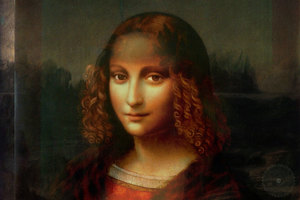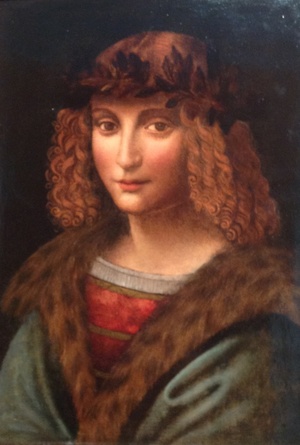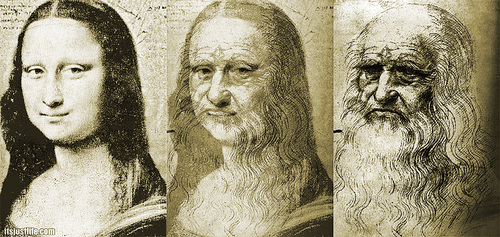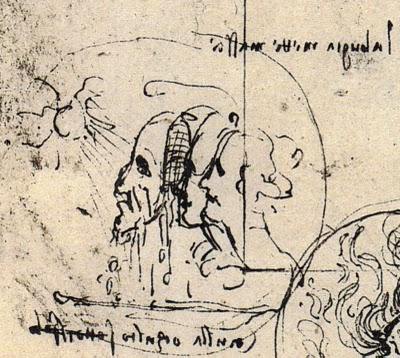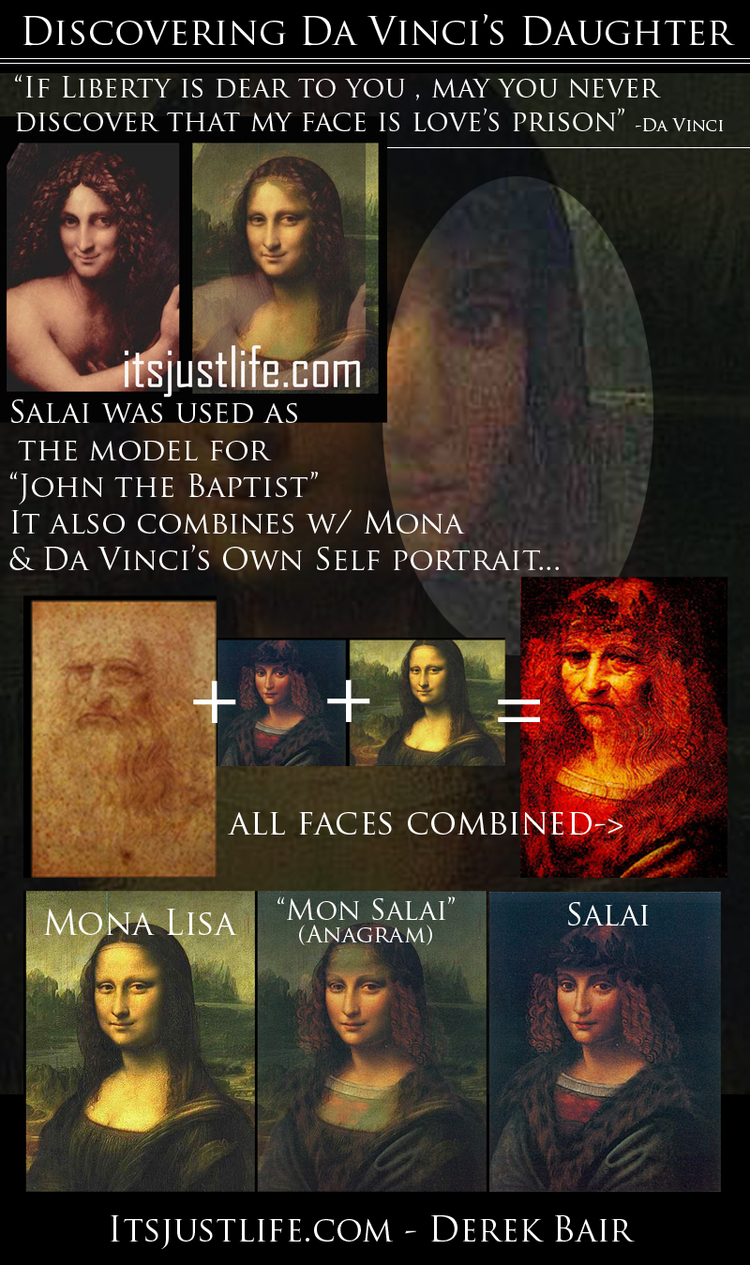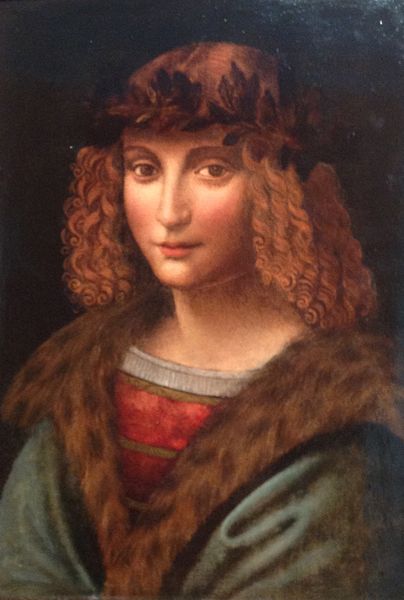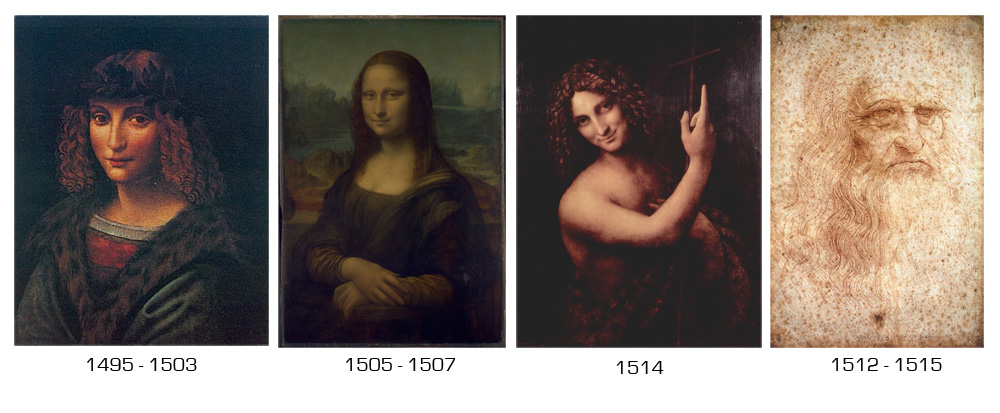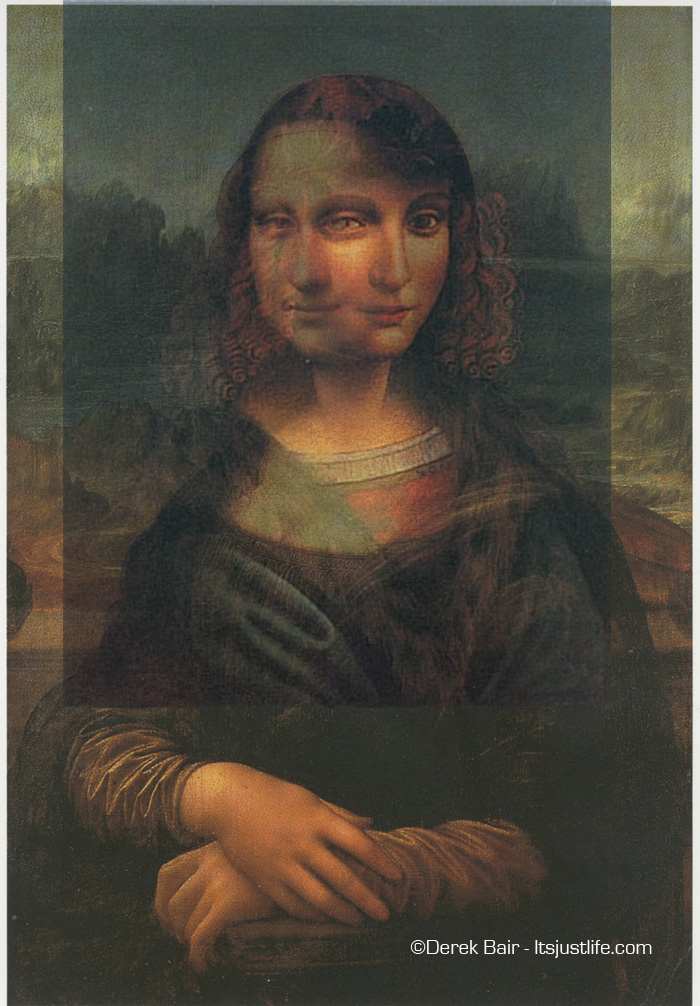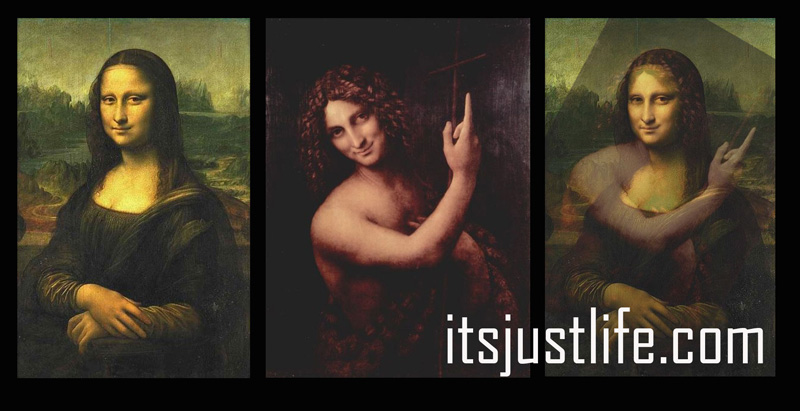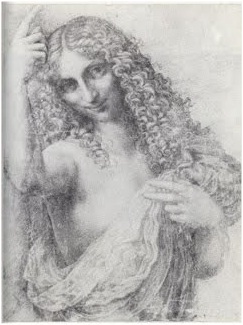Mon Salai
This is a painting of Da Vinci's pupil, assistant, and lover Salino Giacomo, or "Salai." Why is the title "Mona Lisa" an anagram for "Mon Salai" ? Why does a painting of Salai combine with the painting of Mona Lisa?
M.on Salai
The Portrait of Salai and the Mona Lisa's faces combined at 50% transparency.
Mon Salai: The Anagram Hidden in the Mona Lisa
Did you know that "Mon Salai" is an anagram of "Mona Lisa"? In French, "Mon Salai" translates to "My Salai," a name steeped in significance for Leonardo da Vinci. Leonardo, known for his love of puzzles and word games, may have intentionally embedded this play on words into his most famous painting. The mysteries and curiosities surrounding the Mona Lisa can, in part, be explained by discoveries I’ve made over recent years.
In my research, I’ve found compelling evidence that Salai, Leonardo’s apprentice and muse, was also a basis for the Mona Lisa. A painting of Salai, created before the Mona Lisa, can be purposefully superimposed over her, revealing striking similarities. Salai’s nickname, “Salino,” adds another layer to the puzzle, as it also serves as an anagram: "ona lisa."
The connections don’t stop there. The bridge in the background of the Mona Lisa has been identified by some as “The Devil’s Bridge,” a nod to Salai, whose name translates to "Little Devil." Another anagram of "Mona Lisa" is "M onSalai," hinting at a deeper link between Leonardo’s masterpiece and his beloved Salai.
Leonardo’s penchant for embedding secrets and multilayered meanings into his work suggests that the Mona Lisa is more than just a portrait—it’s a cipher, a testament to his artistic and intellectual brilliance, and an eternal mystery waiting to be unraveled.
Portrait of Salai combined with the Mona Lisa
The Daughter of Art and Genius: A Hidden Connection
One of my most intriguing discoveries is the result of superimposing two iconic images: Leonardo da Vinci’s self-portrait and the Mona Lisa. When these two works are combined, they create a new "Daughter" image—both literally and metaphorically. This concept mirrors the modern practice of blending two faces to imagine their offspring, offering a profound insight into Leonardo’s artistic intent.
The Mona Lisa, often viewed as a mysterious standalone masterpiece, takes on an even deeper meaning when seen through this lens. Could Leonardo have intentionally designed the Mona Lisa as a reflection of himself, an artistic "child" born of his genius and experimentation? The alignment of these two faces is so precise that it defies coincidence, suggesting an intimate connection only Leonardo could conceive.
Leonardo’s cryptic writings further amplify this discovery. Consider his line:
"Do not reveal, if freedom is dear to you, that my face is the prison of love."
Could this be a veiled reference to his own identity hidden within the Mona Lisa? The blending of these images not only showcases Leonardo’s unparalleled skill but also reveals layers of symbolism—love, legacy, and the melding of artist and muse into a single, timeless creation.
This revelation invites us to view the Mona Lisa not just as a singular portrait but as a puzzle, a dialogue between Leonardo and his viewers, and perhaps a reflection of his own humanity.
If Salai's face aligns with the Mona Lisa that means that it also aligns with Leonardo's self portrait since it also aligns with the Mona Lisa.
Here’s a refined and formatted version of your text for clarity and flow, ready for inclusion on your site or publication:
A Love Hidden in Art: The Story Behind the Mona Lisa
Leonardo da Vinci and his apprentice Salai lived in a time when their relationship—if revealed—could have had dire consequences. As two men who could not biologically have a child together, they instead created one in the form of a painting: the Mona Lisa. This theory provides an explanation for the cryptic nature and strange coincidences surrounding not only the Mona Lisa but also many of Leonardo’s works.
The secrecy was not merely artistic; it was a necessity. Expressing their bond openly could have resulted in death, destruction of their work, and erasure of their legacy. Instead, Leonardo left behind clues—hidden signs and symbols—that have gone largely unnoticed for centuries. Only with the advent of photography, digital media, and the internet have more of his art and notebooks become accessible, allowing for deeper analysis and unexpected connections.
Following the Clues
Coming into Leonardo’s world with fresh eyes, I began to notice what I first took as coincidences—small, seemingly unrelated details scattered across his work. But as these “coincidences” piled up, they began to form a larger picture, one that pointed to a hidden story.
Initially, I played the role of “Derek’s advocate,” challenging my own conclusions and exploring alternate explanations. Yet every path I took seemed to lead back to this theory, no matter how crazy or controversial it might seem.
The key revelation came when I discovered that superimposing the Mona Lisa and Salai’s portraits creates a perfect alignment—a “Daughter” image, both metaphorically and literally. The precision of this alignment is no accident. I’ve worked extensively with digital media and photography, and even with modern tools, it is nearly impossible to achieve such perfect alignment between two faces intentionally. That Leonardo managed this with two separate paintings centuries ago is undeniable proof of a deliberate connection.
Evidence in Plain Sight
If Leonardo wanted to tell this story, why didn’t he leave behind explicit evidence? The answer lies in the dangerous social climate of his time. Openly revealing the nature of this connection could have endangered his life and work. Instead, he embedded clues within his art, layered under his signature technique of sfumato and hidden within his notebooks.
Leonardo's own words, such as the cryptic phrase “Do not reveal, if freedom is dear to you, that my face is the prison of love,” may hint at this very secret. These words, paired with the meticulous alignment of the paintings, suggest a story intentionally veiled, meant to be discovered only by those who dared to look closely.
Beyond Coincidence
What began as a single “coincidence” has grown into a tapestry of interconnected details. Each discovery builds on the last, forming a narrative too intricate to dismiss. I explore these connections in exhaustive detail in my book, where I dissect the art, the history, and the implications of this theory.
Ultimately, the Mona Lisa and Salai’s faces are undeniably connected, whether as artistic experimentation, an intentional puzzle, or a deeply personal expression of love and legacy. Whatever the truth, one thing is clear: Leonardo da Vinci created not just a painting, but an enduring enigma that continues to captivate and inspire.
This shows the portrait of Salai (c.1495-1500) being superimposed over the Mona Lisa (c. 1500-1519)
“The lover is moved by the beloved object as the senses are by sensual objects; and they unite and become one and the same thing. The work is the first thing born of this union; if the thing loved is base the lover becomes base.”
— Leonardo da Vinci
An article about this from 2006 can be read here:
The detail from a page of Leonardo's notebooks shows he thought of the idea of superimposing faces. This page has the following cryptic passage with it which I think alludes to the faces being combined. A further explanation will be presented in it's chapter in my book.
"Truth – The Sun
Falsehood – A mask
Innocence
Malignity
Fire destroys falsehood – that is sophistry – and restores truth, driving out darkness.
Fire may be represented as the destroyed of all sophistry and as the image and demonstration of truth: because it is light and drives out darkness wich conceals all essence or subtle things..
Truth
Fire destroys all sophistry – that is deceit – and maintains truth alone – that is, gold. Truth at last cannot be hidden. Dissimulation is of no avail. Dissimulation is to no purpose before so great a judge.
Falsehood puts on a mask. Nothing is hidden under the sun. Fire is to represent truth because it destroys all sophistry and here lies: and the mask is for lying and falsehood which conceal truth.” – Leonardo da Vinci.

